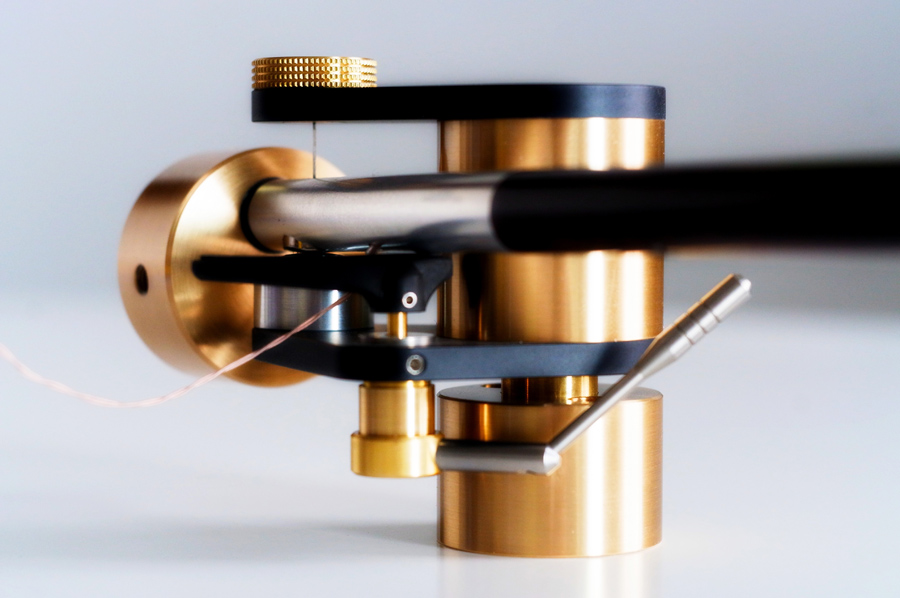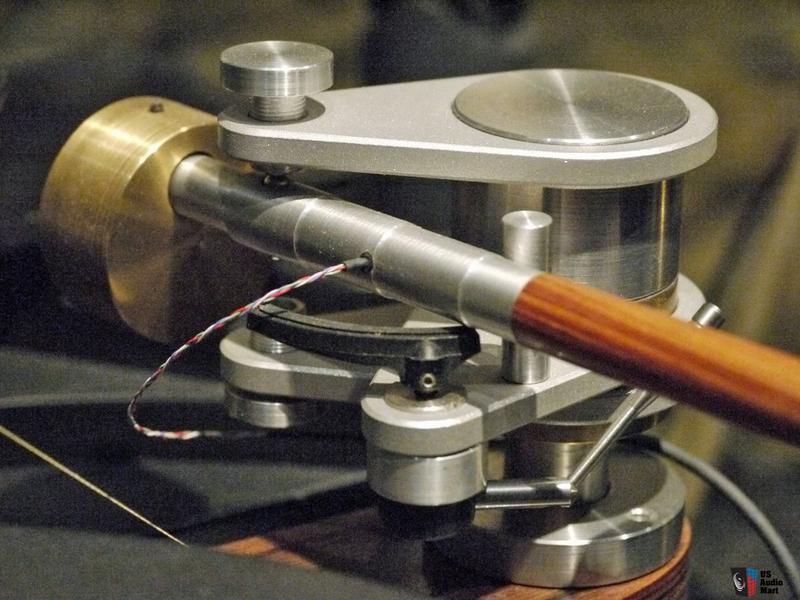You are using an out of date browser. It may not display this or other websites correctly.
You should upgrade or use an alternative browser.
You should upgrade or use an alternative browser.
DIY tonearm
- Thread starter Joe
- Start date
Joe
pfm Member
Here's the 12" Kuzma specs
Effective length: 304.8mm
Mounting distance: 291mm
Offset angle: 17.8 degrees
Effective mass; 13g
Pivot height: Platter level.
How is effective mass calculated?
MJS
Technical Tinkerer
There was someone used arrow shafts quite successfully to make a tonearm I think.
That'll be the one in the diagram above. Hence the name!
The tonearm's effective mass is its moment of inertiaHow is effective mass calculated?
https://en.m.wikipedia.org/wiki/Moment_of_inertia
It's the mass "seen" by the cartridge as it tries to rotate the tonearm about it's axes. And hence may be different in the different access of movement (nominally horizontal & vertical)
The arm's effective mass without cartridge - the value that's typically specified - will be different (lower) than the effective mass once the cartridge (and screws and headshell wires) have been added
Joe
pfm Member
The tonearm's effective mass is its moment of inertia
https://en.m.wikipedia.org/wiki/Moment_of_inertia
It's the mass "seen" by the cartridge as it tries to rotate the tonearm about it's axes. And hence may be different in the different access of movement (nominally horizontal & vertical)
The arm's effective mass without cartridge - the value that's typically specified - will be different (lower) than the effective mass once the cartridge (and screws and headshell wires) have been added
yerbut... how is the effective mass worked out?
Well the detailed (but possibly not fully helpful) answer is in the original article
The article also gives ways of measuring it on a finished item
If you want to try to model/predict it then, have a look at
https://en.m.wikipedia.org/wiki/List_of_moments_of_inertia
Looking at the list of defined examples (under the Moments of inertia section) you could nominally use these to give a prediction.
For example, you could arguably model a tonearm as a combination (sum) of
I'd also guess that something like solidworks would calculate the moment of inertia of a design assembly
There is no one single simple formula for a tonearm
You're going to have to calculate it for yourself
You've got to understand the basics of the above maths in order to do it
In summary your options are (other options welcome)
I = integral r^2 dm
..the sum of all the particles of mass in the arm, times the radius squaredThe article also gives ways of measuring it on a finished item
If you want to try to model/predict it then, have a look at
https://en.m.wikipedia.org/wiki/List_of_moments_of_inertia
Looking at the list of defined examples (under the Moments of inertia section) you could nominally use these to give a prediction.
For example, you could arguably model a tonearm as a combination (sum) of
- main pivot to headshell part of the arm - a rod pivoted at one end
- counterweight stub - a rod pivoted at one end
- headshell - a point mass
- counterweight - a point mass
- or a thick rod pivoted at one end
- or, because the counterweight doesn't actually start at the pivot,- a thick rod the diameter of counterweight, pivoted at one end, of length to the furthest edge of the counterweight
- minus - the same thick rod, pivoted at one end, of length to the nearest edge of the counterweight
- a thick rod the diameter of counterweight, pivoted at one end, of length to the furthest edge of the counterweight
- ...etc.
- building up your model in ever more detail
I'd also guess that something like solidworks would calculate the moment of inertia of a design assembly
There is no one single simple formula for a tonearm
You're going to have to calculate it for yourself
You've got to understand the basics of the above maths in order to do it
In summary your options are (other options welcome)
- calculate based on simplified models as above
- use a suitable CAD package (I assume there's one somewhere)
- build it then measure it empirically
Joe
pfm Member
I am going to build a couple ( maybe several ) arms and I am going to try and keep as much as possible in common between them,
For example....
These two designs could both be made with very little difference in machining between them.
I intend to build both types and see which I prefer.
I like their apparent simplicity.. it would suit my deck.


For example....
These two designs could both be made with very little difference in machining between them.
I intend to build both types and see which I prefer.
I like their apparent simplicity.. it would suit my deck.


Joe
pfm Member
Oh come all ye physicists 
I don't know if you can see in the upper photo ^^^ on the arm suspended by a thread ? The arm is 'held' in place by two magnets.One in the arm under the thread is attracted to one set in the lower 'gallows' plate.
Question... the one in the arm is slightly curved ( around the radius of the curve of the arm tube ) ..I need to do this to a neodymium magnet , which will create quite a number of problems that would be good to avoid.
Someone on another forum suggested filing a curve onto a piece of soft iron to fit over the face of the magnet instead of shaping the magnet itself. The iron would be easier to work on but would still need plating to avoid future corrosion issues... as would the neodymium.
So.. that question... would the iron facing act as a pole piece? If it did would it alter the magnetic field in a way different to just curving the face of a magnet ? in short.. would it work?
I don't know if you can see in the upper photo ^^^ on the arm suspended by a thread ? The arm is 'held' in place by two magnets.One in the arm under the thread is attracted to one set in the lower 'gallows' plate.
Question... the one in the arm is slightly curved ( around the radius of the curve of the arm tube ) ..I need to do this to a neodymium magnet , which will create quite a number of problems that would be good to avoid.
Someone on another forum suggested filing a curve onto a piece of soft iron to fit over the face of the magnet instead of shaping the magnet itself. The iron would be easier to work on but would still need plating to avoid future corrosion issues... as would the neodymium.
So.. that question... would the iron facing act as a pole piece? If it did would it alter the magnetic field in a way different to just curving the face of a magnet ? in short.. would it work?
misterdog
Not the canine kind
Ask Anchor magnets, conveniently located in Sheffield if they can produce such ?
https://www.anchormagnets.com/products/neodymium/
https://www.anchormagnets.com/products/neodymium/
JemHayward
pfm Member
I recall from playing with magnets as a child that as you rotate a magnet, relative to its twin, the magnetic field can change from attraction to repulsion, which would do some pretty strange things to the stability. I think the important thing is to align the two magnets so that the opposing poles are always pointing at each other. Could you not do this my having the magnet in the arm tube poking out below the tube. If you want to attach the magnet to the curve of the tube, you could use any material you like between the flat upper face of the magnet and the curve of the tube, as it won't be part of the magnetic 'circuit'.
Joe
pfm Member
Frank Schroeder has been in touch and explained the curvature of the upper and lower magnets to me... I now just have to try and understand his explanation.
So.. magnets now ordered along with materials to make a jig to hold the magnets to be able to shape them.
Let the games commence !
So.. magnets now ordered along with materials to make a jig to hold the magnets to be able to shape them.
Let the games commence !
Joe
pfm Member
Good luck shaping the magnets Joe - perhaps grind them with a Dremel whilst turning in the lathe.
Somewhere in the swamp of my memory I have the fact that neodymium magnets start to loose magnetism above 80 C ( probably complete codswallop knowing my memory )
I think I will start with hand filing and see how it goes.
Shame is a couple of months ago I throw out a water cooled diamond wheel tile cutter. Would have been just the job.
Magnets tend to be SERIOUSLY hard - I have tried with a green wheel in the past and barely touched them. This is why they are manufactured by sintering powders pressed to the required final shape. I doubt that you will be able to machine any magnet, no matter what you try.
As for temperatures/magnetism - what you need is the Curie temperature. Heat is just atomic vibration - more vibration, higher temperature. As vibration increases, the magnetic domains within a magnet become mobile/fragile, so tend to either randomise (within an existing magnet), or align, if in a magnetic field.
As for temperatures/magnetism - what you need is the Curie temperature. Heat is just atomic vibration - more vibration, higher temperature. As vibration increases, the magnetic domains within a magnet become mobile/fragile, so tend to either randomise (within an existing magnet), or align, if in a magnetic field.

